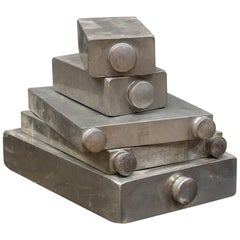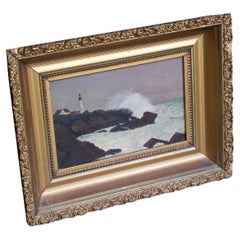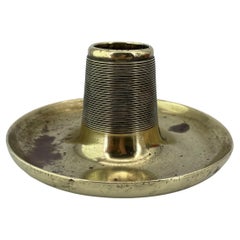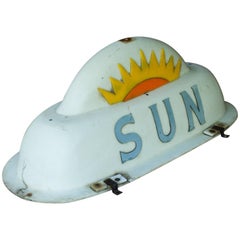Want more images or videos?
Request additional images or videos from the seller
1 of 7
Rare 19th Century Oyster Can WM.D. Gude & Company Quart Baltimore Chesapeake Bay
Price:$1,400
$2,000List Price
About the Item
- Dimensions:Height: 7 in (17.78 cm)Diameter: 3.38 in (8.59 cm)
- Style:Late Victorian (Of the Period)
- Materials and Techniques:Tin,Painted
- Place of Origin:
- Period:
- Date of Manufacture:1880s
- Condition:Wear consistent with age and use.
- Seller Location:Hyattsville, MD
- Reference Number:1stDibs: LU985715573391
About the Seller
5.0
Gold Seller
Premium sellers maintaining a 4.3+ rating and 24-hour response times
Established in 2003
1stDibs seller since 2013
781 sales on 1stDibs
Authenticity Guarantee
In the unlikely event there’s an issue with an item’s authenticity, contact us within 1 year for a full refund. DetailsMoney-Back Guarantee
If your item is not as described, is damaged in transit, or does not arrive, contact us within 7 days for a full refund. Details24-Hour Cancellation
You have a 24-hour grace period in which to reconsider your purchase, with no questions asked.Vetted Professional Sellers
Our world-class sellers must adhere to strict standards for service and quality, maintaining the integrity of our listings.Price-Match Guarantee
If you find that a seller listed the same item for a lower price elsewhere, we’ll match it.Trusted Global Delivery
Our best-in-class carrier network provides specialized shipping options worldwide, including custom delivery.You May Also Like
1856 U.S. Coast Survey Map of Chesapeake Bay and Delaware Bay
Located in Colorado Springs, CO
Presented is U.S. Coast Survey nautical chart or maritime map of Chesapeake Bay and Delaware Bay from 1856. The map depicts the region from Susquehanna, Maryland to the northern Outer Banks in North Carolina. It also shows from Richmond and Petersburg, Virginia to the Atlantic Ocean. The map is highly detailed with many cities and towns labeled throughout. Rivers, inlets, and bays are also labeled. Various charts illustrating more specific parts of the region are marked on the map using dotted lines. The lines form boxes, and the corresponding chart number and publication date are given. Extensive triangulation surveys were conducted the length of Chesapeake Bay and are illustrated here. Hampton Roads, Virginia is labeled, along with the James, York, and Rappahannock Rivers, which were all extensively surveyed.
The chart was published under the supervision of A. D. Bache, one of the most influential and prolific figures in the early history of the U.S. Coast Survey, for the 1856 Report of the Superintendent of the U.S. Coast Survey. Alexander Dallas Bache (1806-1867) was an American physicist, scientist, and surveyor. Bache served as the Superintendent of the U.S. Coast Survey from 1843 to 1865. Born in Philadelphia, Bache toured Europe and composed an important treatise on European Education. He also served as president of Philadelphia's Central High School and was a professor of natural history and chemistry at the University of Pennsylvania. Upon the death of Ferdinand Rudolph Hassler, Bache was appointed Superintendent of the United States Coast Survey.
The Office of the Coast Survey, founded in 1807 by President Thomas Jefferson and Secretary of Commerce Albert Gallatin...
Category
Antique 1850s American Maps
Materials
Paper
Rare 19th Century Automaton Theater
Located in Madrid, ES
This important and rare automaton theater dates from the late 19th century and features both its original mechanical system and later electrical modifications.
Materials: Constructe...
Category
Antique 1890s Toys and Dolls
Materials
Fruitwood
19th Century Victorian Great Western Railway Company Painted Coach Panel, c.1860
Located in Royal Tunbridge Wells, Kent
Antique 19thC Victorian coach panel, hand painted, showing the emblem of The Great Western Railway Company. Founded in Bristol by Isambard Kingdom Brun...
Category
Antique 19th Century British Victorian Historical Memorabilia
Materials
Wood
$2,052
H 28.35 in W 22.45 in D 1.19 in
Imperial Company Disc Playing Music Box, American 19th Century
Located in San Francisco, CA
The Imperial Company music box with one disc, the disc is titled The Geisha. Refinished mahogany case. The player is in working condition with good tone.
Late 19th century.
Category
Antique Late 19th Century American Musical Instruments
Materials
Mahogany
Very Rare 19th Century Italian Trompe L'oeil Panels
Located in London, GB
19th century Italian trompe l'oeil panels
We are proud to offer a spectacular pair of highly decorative 19th century Italian trompe l'oeil panels, each depicting an architectural b...
Category
Antique 1850s Italian Early Victorian Sculptures and Carvings
Materials
Wrought Iron
Rare 19th Century English Tunbridgeware Hair Pin or Slide
Located in Dallas, TX
PRESENTING an EXTREMELY UNIQUE and RARE 19C British Tunbridgeware Hair Pin/Bobbin or Slide.
This slide is unlike any of it’s kind we have seen before, it is a VERY RARE survivor.
From circa 1860 – 80 and made in Tunbridge Wells, England.
Made of walnut with gorgeous marquetry inlay on the entirety of the front with classic Tunbridgeware micro-mosaic all over the front. The rear is walnut.
The marquetry inlay appears to be various different woods, namely, maple, walnut and satinwood.
Would have been worn in a Lady’s hair bun with the micro-mosaic facing forward.
This would have belonged to a VERY ELEGANT LADY in the mid to late 19th Century.
Tunbridge ware is a form of decoratively inlaid woodwork, typically in the form of boxes, that is characteristic of Tonbridge and the spa town of Royal Tunbridge Wells in Kent in the 18th and 19th centuries. The decoration typically consists of a mosaic of many very small pieces of different coloured woods that form a pictorial vignette. Shaped rods and slivers of wood were first carefully glued together, then cut into many thin slices of identical pictorial veneer with a fine saw. Elaborately striped and feathered bandings for framing were pre-formed in a similar fashion.
There is a collection of Tunbridge ware in the Tunbridge Wells Museum and Art Gallery in Tunbridge Wells.
The famous makers of Tunbridge ware were in the Tunbridge Wells area of Kent; their most notable work was from circa 1830-1900.
Early makers of Tunbridge ware, in Tunbridge Wells in the mid-18th century, were the Burrows family, and Fenner and Co. In the 19th century, around 1830, James Burrows invented a technique of creating mosaics from wooden tesserae. Henry Hollamby, apprenticed to the Burrows family, set up on his own in 1842 and became an important manufacturer of Tunbridge ware, employing about 40 people.
Edmund Nye (1797–1863) and his father took over the Fenner company when William Fenner retired in 1840, after 30 years in partnership with him. Thomas Barton (1819–1903), previously apprenticed at the Wise factory, joined the Nyes in 1836, and worked as Nye’s designer; he took over the business in 1863 and continued there until his death.
In Tonbridge (near to Tunbridge Wells), George Wise (1703–1779) is known to have had a business in 1746. It continued with his son Thomas, and Thomas’s nephew George (1779–1869), who took over in 1806. In its early years the company made articles such as workboxes and tea caddies with prints of popular views; later items had pictures created from mosaics. Their workshop in Tonbridge, Wise’s Tunbridge Ware Manufactory, was next to the Big Bridge over the Medway; the building was demolished in 1886 to widen the approach to the bridge.
Tunbridge ware became popular with visitors to the spa town of Tunbridge Wells, who bought them as souvenirs and gifts. Articles included cribbage boards, paperweights, writing slopes, snuffboxes and glove boxes.
At the Great Exhibition of 1851, Tunbridge ware by Edmund Nye, Robert Russell and Henry Hollamby was shown; Edmund Nye received a commendation from the judges for his work. He exhibited a table depicting a mosaic of a ship at sea; 110,800 tesserae were used in making the picture.
The manufacturers of Tunbridge ware were cottage industries, and they were no more than nine in Tunbridge Wells and one in Tonbridge. The number declined in the 1880s; competent craftsmen were hard to find, and public tastes changed. After the death of Thomas Barton in 1903 the only surviving firm was Boyce, Brown and Kemp, which closed in 1927.
Marquetry was an old technique which was continued by Nye and Barton to create images such as birds or butterflies.
‘Green Oak’ as caused by the fungus Chlorociboria aeruginascens.
Stickware and half-square mosaic was invented by James Burrows in about 1830: a bunch of wooden sticks of different colours, each having triangular or diamond-shaped cross section, were tightly glued together; in the case of stickware, the resulting block was dried, then turned to form an article such as the base of a pincushion. For half-square mosaic, thin slices were taken from the composite block, and applied to a surface.
Tesselated mosaic, was a development by James Burrows of half-square mosaic; it was adopted by George Wise and Edmund Nye. Minute tesserae were used to form a wide variety of geometric and pictorial designs.
Many sorts of wood were used for the various colours; about 40 were in regular use. Only natural colors were used; green was provided by “green oak”, produced by the action of fungus on fallen oak. Designs for articles were often taken from designs of Berlin wool work.
Category
Antique Late 19th Century English High Victorian Collectible Jewelry
Materials
Satinwood, Walnut
Antique English Brass reception bell 19th Century
Located in Chonburi, TH
Antique English Bronze reception bell with original patina. The bell still works great!
Category
Antique 19th Century English Late Victorian Musical Instruments
Materials
Bronze
Rare 19th Century Meerschaum Pipe – Bullfight Scene
Located in Madrid, ES
Exceptional and rare 19th century meerschaum pipe, finely carved, depicting a detailed bullfight scene. The composition depicts a dramatic moment where one bullfighter is assisted by...
Category
Antique 19th Century Spanish Other Tobacco Accessories
Materials
Organic Material
19th-Early 20th Century S.F Bay Area Leather Bound Business Journals
Located in San Francisco, CA
19th-early 20th century S.F Bay Area Leather Bound Business Journals
One journal is mostly filled in. The other is mostly empty.
The dates are circa 1880s-1910s
An interesti...
Category
Antique Late 19th Century American Books
Materials
Paper
$750 / set
H 15 in W 10 in D 1 in
Antique Rare Judaica Dreidel Germany 19th Century
Located in Doha, QA
An absolutely unique Bone Dreidel originated from Germany in 19th century. It has six sides shaping Star of David. Each side has one or two Yiddish letters on top which refer to an O...
Category
Antique 19th Century German Religious Items
Materials
Bone
More From This Seller
View AllEarly 19th Century English Pewter Travel Slab Flasks Prohibition Gustavian Style
By Abercrombie & Fitch
Located in Hyattsville, MD
Set of Five Included.
Wonderful forms, decor conversation pieces. Two double chambers, and three single chamber flasks, no punctures. Bent, dented and scratched from normal uses.
...
Category
Vintage 1920s English Late Victorian Historical Memorabilia
Materials
Pewter
Antique Late 19th Century Seascape Lighthouse Oil Painting
Located in Hyattsville, MD
Unsigned Maritime oil painting. Very good quality, by the hand of a professional painter. The painting is soiled from 100 years of exposure. The frame has some losses (chips) to the ...
Category
Antique 19th Century American American Classical Paintings
Materials
Wood
$556 Sale Price
20% Off
19th Century Sailboat Yacht Ships Ashtray Match Striker Manhattan Brass Co NYC
Located in Hyattsville, MD
A rare 19th Century Yachts Match-Striker Ashtray by the Manhattan Brass Company of New York City. Stamped M.B. Co. New York. The weight is 2 lbs 9...
Category
Antique 1880s American American Colonial Tobacco Accessories
Materials
Brass
$1,996 Sale Price
20% Off
Vintage 1950s Baltimore Sun Taxi Cab Sign Car Topper
Located in Hyattsville, MD
Plastic construction. Fairly rare item, Baltimore History.
Category
Vintage 1950s American Machine Age Historical Memorabilia
Materials
Plastic
$708 Sale Price
20% Off
19th Century Frankstein Wall Art Throw Switch Slate Brass New Haven Mfg Co
Located in Hyattsville, MD
Bolt it on the wall for decor on set on a table for conversation. A large example by New Haven Manufacturing Co. of Connecticut, c.1890s.
L 14.5 x W 5.5 x Thk 3 in
Category
Antique 1890s American Industrial Scientific Instruments
Materials
Slate, Brass
1880s Pennsylvania Railroad Company Flyer Steam Train Locomotive Bronze Bell PRR
Located in Hyattsville, MD
Rings beautifully, and moves smoothly. Gifted from the Governor of Pennsylvania, David Lawerence to the Chancellor of the University of Pittsburgh...
Category
Antique 19th Century American Industrial Architectural Elements
Materials
Iron, Bronze
$8,000 Sale Price
33% Off
Recently Viewed
View AllMore Ways To Browse
Baltimore Antique Furniture
Rare Antique Tins
Oyster Cans
Painted Baltimore Furniture
Antique Oyster Tins
Oyster Tins
Collectable Brass Ship
Marine Antiques
Antique Cardboard Boxes
Bronze Ship
Nautical Flag
Used Rudder
Antique Pulley
Antique Brass Cylinder
Vintage Signal Flag
Signal Flag
Ship Porthole
Antique Shell Collection



